The construction of the wonderful canon of logarithms
The construction of the wonderful canon of logarithms
The construction of the wonderful canon of logarithms
Create successful ePaper yourself
Turn your PDF publications into a flip-book with our unique Google optimized e-Paper software.
, A<br />
52 Appendix.<br />
saving <strong>of</strong> half <strong>the</strong> Table <strong>of</strong> Loga-<br />
RITHMS.<br />
OF two arcs making up u quadrant, as <strong>the</strong> sine <strong>of</strong> <strong>the</strong><br />
greater is to <strong>the</strong> sine <strong>of</strong> double its arc, so is <strong>the</strong> sine<br />
<strong>of</strong> 30 degrees to <strong>the</strong> sine <strong>of</strong> <strong>the</strong> less. Whence <strong>the</strong> Logarithm<br />
<strong>of</strong> <strong>the</strong> double arc being added to <strong>the</strong> Logarithm <strong>of</strong> 2,0<br />
degrees, and <strong>the</strong> Logarithm <strong>of</strong> <strong>the</strong> greater being subtracted<br />
front <strong>the</strong> sum, <strong>the</strong>re remains <strong>the</strong> Logarithm <strong>of</strong> <strong>the</strong> less.<br />
<strong>The</strong> relations<br />
<strong>of</strong> Logarithms &<br />
<strong>the</strong>ir natural numbers<br />
to<br />
each o<strong>the</strong>r.<br />
[A] I. T Et two sines and <strong>the</strong>ir Logarithms be given. If as<br />
J— ' many numbers equal to <strong>the</strong> less sine be multiplied<br />
toge<strong>the</strong>r as <strong>the</strong>re are units in <strong>the</strong> Logarithm <strong>of</strong><strong>the</strong> greater;<br />
and on <strong>the</strong> o<strong>the</strong>r hand, as many numbers equal to <strong>the</strong><br />
greater sine be multiplied toge<strong>the</strong>r as <strong>the</strong>re are units in<br />
<strong>the</strong> Logarithm <strong>of</strong> <strong>the</strong> less ; two equal numbers will be produced,<br />
and <strong>the</strong> Logarithm <strong>of</strong> <strong>the</strong> sine so produced will be<br />
<strong>the</strong>product <strong>of</strong> <strong>the</strong> two Logarithms.<br />
2. As <strong>the</strong> greater sine is to <strong>the</strong> less, so is <strong>the</strong> velocity <strong>of</strong><br />
increase or decrease <strong>of</strong> <strong>the</strong> Logarithms at <strong>the</strong> less, to <strong>the</strong><br />
velocity <strong>of</strong> increase or decrease <strong>of</strong> <strong>the</strong> Logarithms at <strong>the</strong><br />
greater.<br />
3. Two sines in duplicate, triplicate, quadruplicate, or<br />
o<strong>the</strong>r ratio, have <strong>the</strong>ir Logarithms in double, triple, quadruple,<br />
or o<strong>the</strong>r ratio.<br />
4. And two sines in <strong>the</strong> ratio <strong>of</strong> one order to ano<strong>the</strong>r order,<br />
as for instance <strong>the</strong> triplicate to <strong>the</strong> quintuplicate, or <strong>the</strong><br />
cube


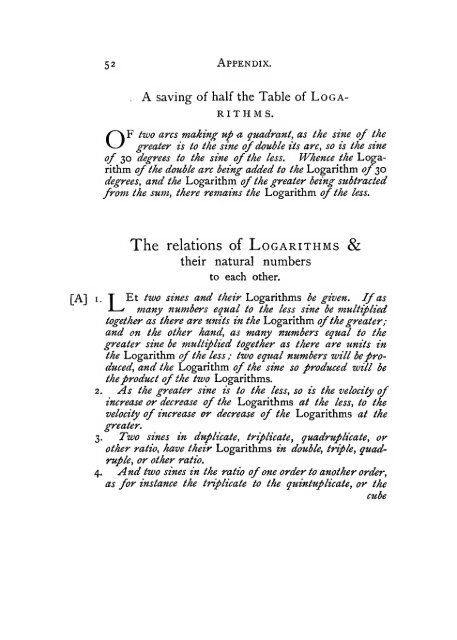
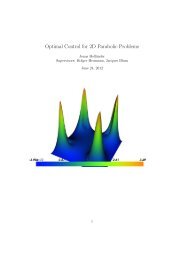
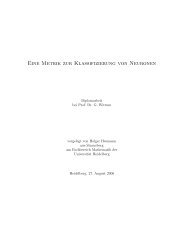
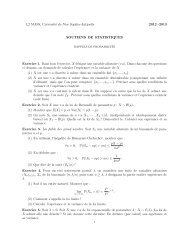
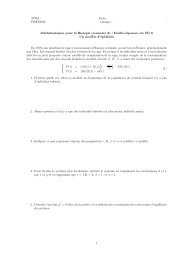


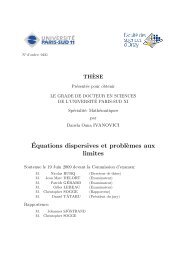
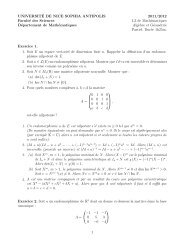
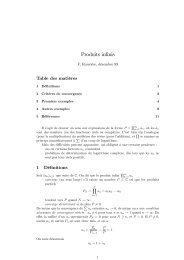
!['eries enti\`eres (+ [D78 Th d'Abel angulaire])](https://img.yumpu.com/14067031/1/184x260/eries-entieres-d78-th-dabel-angulaire.jpg?quality=85)

